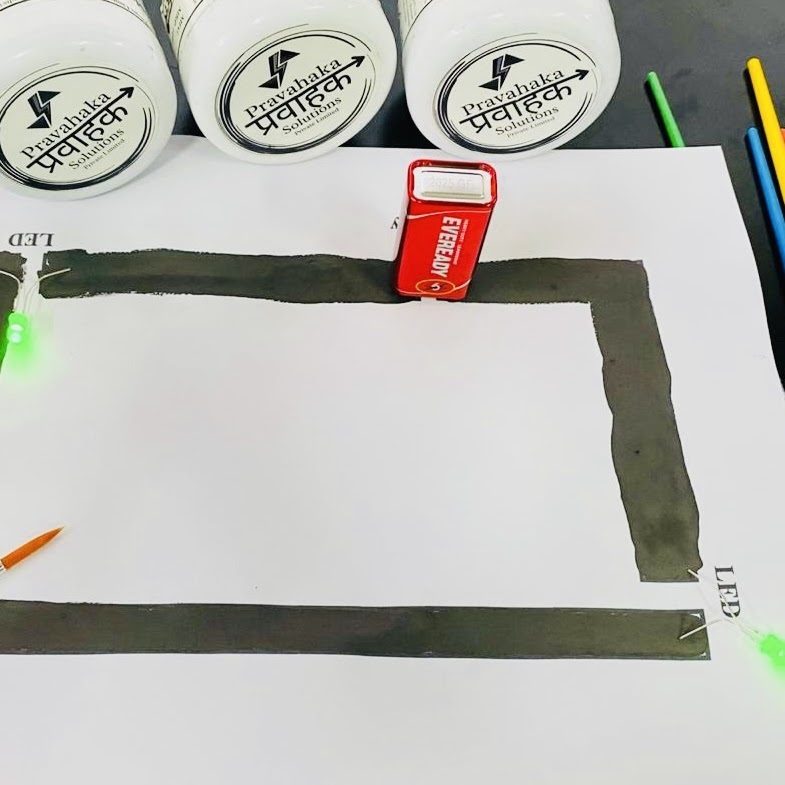
Transform any surface into a circuit. Our highly conductive paint enables the creation of fully functional electronic circuits on a variety of materials—without the need for wires, soldering, or complex tools.
Whether you’re an artist building interactive installations, a researcher designing flexible electronics, or an educator helping students learn electronics hands-on, our conductive paint is the perfect tool for turning ideas into working technology.
🔌 High Conductivity: Ensures efficient current flow and reliable circuit performance
🖌️ Easy to Apply: Brush, stencil, or print it on paper, plastic, fabric, or wood.
🌱 Eco-Friendly & Safe: Water-based, solvent-free formula with low toxicity.
⏱️ Fast-Drying: Circuits can be operational in minutes.
🔄 Flexible & Durable: Withstands bending and light mechanical stress—perfect for wearables and flexible devices.
🧪 Compatible with Low-Voltage Components: Ideal for LEDs, batteries, sensors, and microcontrollers (like Arduino or Raspberry Pi).
Use the paint to design interactive art, light-up illustrations, or touch-sensitive surfaces.
Skip the breadboards. With conductive paint, quickly sketch and test circuit layouts directly on various surfaces.
Enable hands-on learning of circuit concepts in classrooms or maker spaces.

Create precise electrical contacts in experimental setups—especially in applications where silver-based paints are unsuitable.

Paint can be used to fabricate simple, flexible thermoelectric devices for energy harvesting.

Use in paper-based electrochemical biosensors and analytical devices.

The Education Kit is a hands-on learning tool that transforms how students explore electricity, circuits, and creative electronics. By combining conductive paint, LEDs, and everyday materials, this kit allows students to build real circuits on paper, visualize electrical concepts, and ignite curiosity through interactive design.
Whether used in classrooms, maker spaces, STEM clubs, or at home, the kit helps learners of all ages understand how circuits work—no soldering or complex tools required!
🧪 Hands-On Learning: Make learning electronics tangible with real, working circuits.
🧠 STEAM-Focused: Encourages critical thinking, creativity, and scientific inquiry in one activity.
🖌️ Paint Your Circuit: Use the included conductive paint to draw working circuits on paper, wood, cardboard, or fabric.
🧰 Complete Kit: Comes with everything you need—LEDs, batteries, conductive paint, brushes, and instructions.
🎨 Creative Exploration: Combine art and science by designing light-up drawings, greeting cards, paper sculptures, and more.
📘 Curriculum-Friendly: Designed for high school and undergraduate levels but adaptable to younger learners with supervision.
Understand how electricity moves through materials using the paint as a visual conductor.
Connect multiple LEDs in a single path to learn about voltage drops and current flow.
Build a basic Wheatstone Bridge circuit using conductive paint and LEDs to detect small voltage differences—great for learning about sensors and measurement.

Step into the next era of material science with our 2D materials, starting with few-layer graphene—a wonder material just atoms thick, yet stronger than steel and more conductive than copper.
Our 2D materials are engineered for cutting-edge applications in electronics, energy, sensors, and flexible devices. Whether you're in a research lab, an R&D team, or building the next generation of nanoelectronics, our materials provide the foundation for innovation at the atomic scale.
2D materials are crystalline substances consisting of a single layer or just a few layers of atoms. Their ultra-thin structure gives rise to extraordinary properties, making them ideal for miniaturized, high-performance technologies. Our focus:
Few-layer Graphene (2–5 layers)
Synthesized via a green, scalable, and cost-effective method
High conductivity, low defect density, and excellent mechanical flexibility
Excellent electron mobility for high-speed transistors and energy storage devices.
Perfect for bendable sensors, wearable devices, and transparent films.
Consistent performance for both lab research and commercial development.
Produced through a green and affordable process—no harsh chemicals or high-cost equipment needed.
Easily integrated into existing fabrication processes, printing methods, or composites.